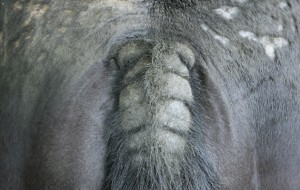 One of the most common problems we get asked about over the spring and summer months is Sweet Itch- a skin allergy triggered by saliva from the Culicoides midge. Once an allergic horse has been exposed to this allergen, a reaction causes histamine to be produced, resulting in swelling and itchy skin. The horse will have an intense desire to rub, scratch or bite the area, which is upsetting for them and you, and often leads to broken skin and open wounds that can become infected. Some horses can be driven mad by sweet itch over the spring and summer, which will can have a detrimental effect on their quality of life, and so their temperament and rideability. Luckily, there are various management techniques that can be adopted to help your horse. The most important thing is to keep up the preventative measures, as even one bite can trigger the reaction.
One of the most common problems we get asked about over the spring and summer months is Sweet Itch- a skin allergy triggered by saliva from the Culicoides midge. Once an allergic horse has been exposed to this allergen, a reaction causes histamine to be produced, resulting in swelling and itchy skin. The horse will have an intense desire to rub, scratch or bite the area, which is upsetting for them and you, and often leads to broken skin and open wounds that can become infected. Some horses can be driven mad by sweet itch over the spring and summer, which will can have a detrimental effect on their quality of life, and so their temperament and rideability. Luckily, there are various management techniques that can be adopted to help your horse. The most important thing is to keep up the preventative measures, as even one bite can trigger the reaction.
- Midges are most active at dawn and dusk, so stabling your horse between 4pm and 8am can often help to reduce the risk of being bitten
- Midges love to breed on damp, wet land, so ideally turn your horse out away from water
- Midges can’t fly against winds, so chose the windiest field possible, and consider using a fan in the stable too
- Using a sweet-itch rug that includes neck and stomach protection will help stop midges biting when horses are turned out
- Lotions and fly repellents may also help to keep the midges at bay
- Feeding skin health supplements can helps soothe the skin and keep it healthy- high inclusions of linseed have been shown to be especially beneficial to those suffering from Sweet Itch, and can reduce the size of the lesion caused by the midge, and work as an anti-inflammatory (O’Neill et al. 2002). Start feeding at least a month before midges start to appear to ensure skin is in prime condition before it gets assailed.
If you would like any further advice please don't hesitate to contact our help and advice line 0800 585525 or www.feedmark.eu.











